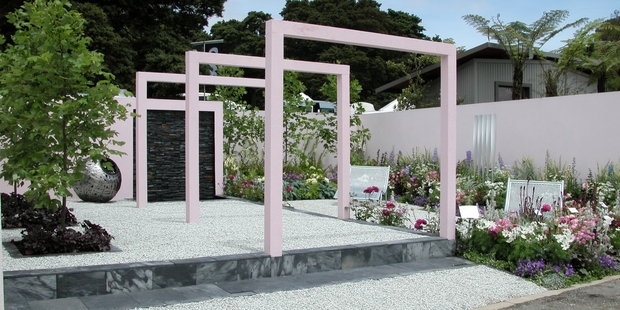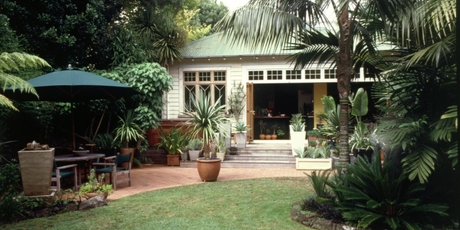LATEST ARTICLES
Topic: Outdoor Structures
Posted by: Tanya Zanfa (Master Admin)
Source: http://www.nzherald.co.nz/hawkes-bay-today/lifestyle/news/article...
Landscaping: Get in tune with rhythm
Landscaping: Get in tune with rhythm
By Leigh Bramwell
6:00 AM Thursday Jul 10, 2014

These pink arches give the garden rhythm.
I've had a couple of people tell me that they've employed a landscape architect to design their gardens, but they don't know what he's talking about.
"He said I needed more rhythm in the garden," one said grumpily. "I thought that's what I got when the kid next door played his drum kit."
I sympathise. I don't know what they're talking about half the time either. So I decided I'd better upskill on garden design terminology, and was relieved to find that be it rhythm, form, line or balance, at least I know it when I see it.
Rhythm
The regular repetition of an element, such as a row of trees alongside a path or driveway, or the posts and rails of a long fence is rhythm. You can create rhythm by adding these elements, like the pink structures pictured above, which were repeated on a smaller scale elsewhere in the design.
Form
Ordinary gardeners call form shape. Easily defined shapes - such as tall, slender cypress or square plinths - are very distinctive and can make a standout, memorable garden.
Line
It sounds like it has more to do with fashion than gardens, but in the outdoor context, line is about any narrow element - a path, a fence, a rill - through the garden. Lines, which can also be curved, can be used to draw people to a certain area, or attract attention to, say, a piece of sculpture you've slaved for weeks to buy.
Balance
This is my favourite. It's the sense you have that what you can see one side of a scene is of equal "weight" to what's on the other side. This does not mean that everything has to be symmetrical or the same size. If, for example, you have five tall conifers on one side of your entranceway, you could balance them with three lower, broader plants on the other side. It's about weight and density rather than uniform height and width. To see if you've achieved it, walk several metres away from whatever you've been working on and see if it looks right. If it does, chances are you've got it.
Proportion
Put simply, proportion means that if you have a 30m palm alongside a long, low house, it will look stupid. It is the relative size of one element to another. Fortunately, they're not usually 30m when you plant them so you'll get away with it for quite a while. If you make a narrow garden bed, the height of the tallest plant should be no more than two-thirds the depth of the bed. So in an 8m x 2m garden, the tallest plant should only be about 120cm tall.

Narrow elements can draw people to a certain area.
Scale
This is about the size of something relative to you. For example, if there are only ever two of you for an al-fresco dinner, don't squeeze a 2m x 2m table into your 4m x 4m courtyard.
You'll look lonely, the table will look enormous and the courtyard will look cramped.
Then there are the more common elements that most of us understand and probably deal with regularly in the garden. Often we employ these techniques subconsciously without ever putting a name to them, but they're no less useful than the designer rules.
Structure
Built elements - pergolas, trellises, walls and the like - add interest, especially in winter when there may not be much else happening. Structures can also provide areas for you to plant against - a garden sited in front of a stone wall will look more interesting than a bed dug into a flat lawn.
Colour
Many gardeners, myself included, struggle with colour, despite the mountains of books and articles that have been written about it. When you're working with colour, step back from the actual shades and look at the intensity. Bright, warm colours create a sense of excitement.
Cool, pale colors and pastels lend a calmer feeling. Single-colour designs are sophisticated; multicolour designs look mad and festive.
Unexpected
Surprises will set your garden apart like nothing else but it's not as simple as plonking down a sandstone sculpture on your terrace.
Try for the unexpected, like a wacky corrugated iron shape at the entrance to a formal garden, or a piece of high-end art alongside a rustic garden shed.
Light Make the garden come alive, and not just at night. Think about positioning shrubs with coloured foliage to catch the early or late sun. We have a stand of large eucalyptus on our eastern boundary and when the trunks catch the western sun it's breathtaking. It's also breathtaking in the wind and we go in fear of being impaled by dead branches when there's a wind warning.
By Leigh Bramwell
- Yardsmart: Want to get greener in 2016? Consider a greenhouse
- Lumo Arkitekter installs tiny shelters in Danish countryside
- Trex Company Debuts New, Modern Pergola Shades
- Epic play structure build time lapse
- Custom Built Gazebo and Grill
- Pool Ramadas and Outdoor Living Structures by California Pools and Landscapes
We promise you'll love our content!





